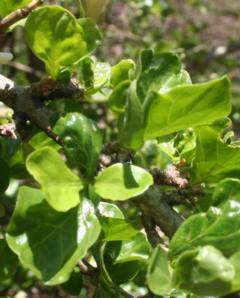Coddia rudis
Coddia rudis (E.Mey. ex Harv.) Verdc.
Family: Rubiaceae
Common names: small bone apple (Eng.); kleinbeenappel (Afr.); umDondwane (Zulu); siKhwakhwane (Siswati); tshinapanapana (Venda)
SA Tree No: 689.1
Introduction
Coddia rudis is usually a short, aromatic, evergreen, dense, multi-stemmed and fairly fast growing shrub.

Description
Description
Coddia rudis is a dense multi-stemmed shrub which grows up to 3 m in height. The main stem is usually short, with arching branches. It grows stiffly upwards, outwards and finally downwards. The bark is dark grey and has no spines. It forms a compact shrub if browsed.

The leaves are opposite or borne in dense clusters on dwarf side twigs. The leaves are simple, broadly obovate, 20 mm wide x 15 mm long, shiny dark green above, paler below, usually hairless, with entire margins, wavy, with round tips which can be notched or broadly tapering. The leaf base is narrowly tapering. The leaf stalks are up to 3 mm long.

The flowers are fragrant, small, up to 10-15 mm in diameter, bell-shaped with 5 lobes, white turning yellow with age, and borne in axillary groups in the leaf axils. They appear just as the new leaves start sprouting in spring (October).
The fruits are greenish-brown, roundish and up to 8 mm in diameter. They are crowned with the remains of the calyx. Fruiting takes place from January to June.
Conservation Status
Status
According to Raimondo et al . (2009), Coddia rudis is of Least Concern (LC).
Distribution and habitat
Distribution description
Coddia rudis occurs from the Eastern Cape through KwaZulu-Natal to the eastern Lowveld and Swaziland, on forest margins, in bush clumps, beneath tall acacias and among rocks. It can tolerate the effect of strong wind, and also survives long periods of drought and high temperatures without extra water.
Derivation of name and historical aspects
History
The specific name is derived from the Latin word rudis meaning rough, coarse or rustic.
Ecology
Ecology
Coddia rudis attracts insects such as bees and butterflies for pollination and in turn the insects become food for birds and other creatures. C. rudis is adapted to dry, sandy soil, strong wind, limited rainfall and intense sunlight.

Uses
Use
Fruits of Coddia rudis are eaten by people and birds, and the leaves are heavily browsed by game. The shrub is useful for planting around the edges of the property to form a green or colourful backdrop, to hide walls, or to create privacy. It can also be used as container plant or ornamental plant.
Growing Coddia rudis
Grow
Coddia rudis grows easily from seed which should be shallowly planted in a good seedling mixture of 50% finely milled pine bark, 25% sand and 25% compost. The seeds should be soaked in warm water for a day before planting. In warm areas the seeds can be planted at any time of the year, but in cold areas one should avoid planting in winter. The seedlings should be transplanted into nursery bags when they reach the two-leaf stage, in the same mixture used in the seed bed.
References
- Johnson, D., Johnson S. & Nichols, G. 2002. Gardening with indigenous trees . Struik, Cape Town.
- Pooley, E. 1993. The complete field guide to trees of Natal, - Zululand and Transkei . Natal Flora Publications Trust, Durban.
- Raimondo, D., Von Staden, L., Foden, W., Victor, J.E., Helme, N.A., Turner, R.C., Kamundi, D.A. & Manyama, P.A. (eds) 2009. Red List of South African plants 2009. Strelitzia 25. South African National Biodiversity Institute, Pretoria.
- Van Wyk, P. 1984. Field guide to trees of the Kruger National Park. Struik, Cape Town .
Credits
William Khutso Sepheka
National Herbarium, Pretoria
December 2012
Plant Attributes:
Plant Type: Shrub, Tree
SA Distribution: Eastern Cape, KwaZulu-Natal, Limpopo, Mpumalanga
Soil type: Loam
Flowering season: Spring
PH: Neutral
Flower colour: White, Yellow
Aspect: Full Sun
Gardening skill: Average
Special Features:
Horticultural zones










Rate this article
Article well written and informative
Rate this plant
Is this an interesting plant?
Login to add your Comment
Back to topNot registered yet? Click here to register.